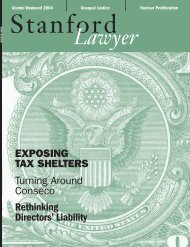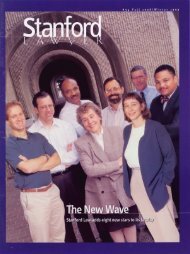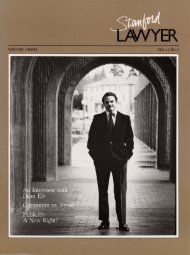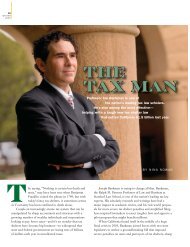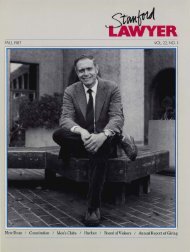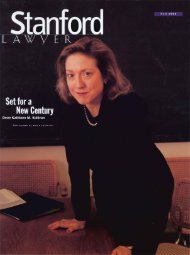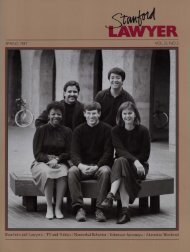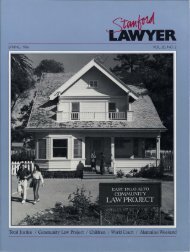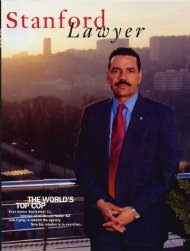Issue 73 - Stanford Lawyer - Stanford University
Issue 73 - Stanford Lawyer - Stanford University
Issue 73 - Stanford Lawyer - Stanford University
You also want an ePaper? Increase the reach of your titles
YUMPU automatically turns print PDFs into web optimized ePapers that Google loves.
38<br />
FALL<br />
2005<br />
DISCOVERY<br />
to internalize all positive externalities and prevent<br />
free riding on intellectual property. Granting<br />
intellectual property rights imposes a complex set<br />
of economic costs, and it can be justified only to<br />
the extent those rights are necessary to provide<br />
incentives to create. The economics of intellectual<br />
property simply do not justify the elimination of<br />
free riding.<br />
How Can We Strike the Right Balance<br />
In the search for the proper economic balance,<br />
the rhetoric of free riding seems unlikely to<br />
offer any substantial aid and quite likely to lead<br />
us astray. The concept of free riding focuses on<br />
the economic effects on the alleged free rider—<br />
whether the accused infringer obtained a benefit<br />
from the use of the invention, and if so whether<br />
it paid for that benefit. The proper focus is on<br />
the intellectual property owner, not the accused<br />
infringer. The question is whether an extension of<br />
intellectual property rights is necessary to permit<br />
intellectual property owners to cover their average<br />
fixed costs. If so, it is probably a good idea. If<br />
not, it is not necessary, and the likelihood that it<br />
will impose costs on competition or future innovation<br />
should incline us to oppose it. Whether an<br />
accused infringer obtained a benefit without paying<br />
for it bears only indirectly on that question.<br />
Free riding encompasses both conduct that simply<br />
captures consumer surplus or other uncompensated<br />
positive externalities and conduct that reduces<br />
the return to the intellectual property owner to<br />
such an extent that it cannot cover its costs. Only<br />
the latter is of concern, and free riding as a concept<br />
will not help us to distinguish the two.<br />
If we are wrong to think of intellectual property<br />
rights in terms of free riding, how then are<br />
we to think of them Several possibilities come<br />
to mind. First, it might be possible to rehabilitate<br />
the property analogy by disconnecting the<br />
concept of property from the arguments against<br />
externalities and free riding. It is possible to talk<br />
of intellectual property as a species of property<br />
more generally without applying the inapt economic<br />
lessons from different types of property<br />
with different characteristics. The key is to think<br />
of property so broadly that different legal regimes<br />
can fit under the tent. As Benjamin Kaplan put<br />
it, “To say that copyright is ‘property’ . . . would<br />
not be baldly misdescriptive if one were prepared<br />
to acknowledge that there is property and property,<br />
with few if any legal consequences extending<br />
uniformly to all species and that in practice the<br />
lively questions are likely to be whether certain<br />
consequences ought to attach to a given piece of<br />
so-called property in given circumstances.”<br />
But these nuanced analyses of the variety of<br />
possible property rules are the exception, not the<br />
rule, in the wave of property-based IP theory and<br />
court decisions. Far more common is an assumption<br />
that intellectual property is just like real<br />
property. My worry is that the rhetoric of property<br />
has a clear meaning in the minds of courts, lawyers,<br />
and commentators as “things that are owned<br />
by persons” and that fixed meaning will make it<br />
too tempting to fall into the trap of treating intellectual<br />
property as an absolute right to exclude.<br />
A second alternative is to treat intellectual<br />
property as a tort. Unlike property systems, which<br />
focus on legally enforceable rights to exclude, tort<br />
systems are intended to compensate injured parties.<br />
A focus on harm to the intellectual property<br />
owner, rather than on the benefit conferred on<br />
the infringer, is consistent with optimal intellectual<br />
property policy. But the analogy to tort<br />
law is far from perfect. Tort law tends to focus on<br />
the defendant’s conduct, assigning blame where<br />
the defendant could have acted differently, rather<br />
than focusing on the incentives given to plaintiffs.<br />
Furthermore, while basic tort principles design<br />
the law around compensating plaintiffs for injury,<br />
a significant branch of tort law is built around the<br />
concept of unjust enrichment—to recapture or<br />
at least to deny to the tortfeasor—positive externalities<br />
or spillovers. My fear is that drawing too<br />
close an analogy to the tort system will encourage<br />
the courts to focus attention on how the defendant<br />
was enriched, not on the need for compensating<br />
intellectual property owners.<br />
Perhaps the closest legal analogy to intellectual<br />
property is a government-created subsidy.<br />
The point of intellectual property law is to depart<br />
from the norm of a competitive marketplace in<br />
order for the government to provide a benefit to<br />
a private party. The government is acting to benefit<br />
the public, supporting innovation that might<br />
otherwise never occur because the market would<br />
undervalue creativity. A similar argument can be<br />
made for welfare and other forms of government<br />
subsidy, such as education—that they are intervening<br />
to help particular people or activities in a<br />
way that the market would not in order to pro-





